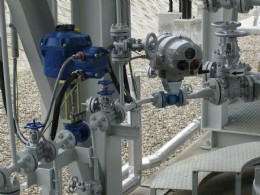Rotork Delivers Isolating And Control Valve Actuation
Rotork delivers all-electric isolating and control valve actuation for gas plants
General view of one of the gas dehydration plants

Rotork CVA (left) and IQT valve actuator installations
The specification for the new plants ruled out the use of air instruments and compressors, dictating the use of explosionproof electric actuators for isolating and control valve duties in the hazardous areas. This has been achieved with ATEX certified Rotork IQT isolating valve actuators and CVA control valve actuators. Both designs feature intrinsically safe, non-intrusive setting and configuration technologies, data logging for diagnostics and preventative maintenance planning, and double-sealed watertight environmental protection. The CVA offers a highly accurate and responsive method of automating control valves, without the complexity and cost of a pneumatic supply. With resolution figures better than 0.1% and the ability to eliminate position overshoot, the CVA helps to maximise product quality and plant capacity.
The electrical supply to the dehydration units is secured by means of a three-tier failsafe system comprising mains power supported by a 30kVA uninterruptable power supply and a 45kVA natural gas powered generator. Centralised control is provided by a Cytect SCADA system and ABB plc, housed in a control room adjacent to each plant. In addition, an Eex-e certified PC with mimic panel and identical graphical interface is located within each plant, enabling operators to work on the system in the field as well as the control room.
The main contractor for the project is Armax Gaz in Romania. Italian companies Pietro Fiorentini and TNC Tecnoconsulting have been responsible respectively for the process and base engineering and the automation and electrical devices, whilst a total of 76 IQT and 41 CVA actuators have been supplied by Rotork Italy.
Rotork Controls Ltd
Tel: 01225 733200
Website: www.rotork.com

| Telephone: | 0113 256 7922 |
| Email: | mail@rotork.com |
| Website: | www.rotork.com |
| More information on the Rotork UK BVAA Member Directory Page |
Search related valve / actuator articles: Rotork UKIssue 18Electric Actuators












